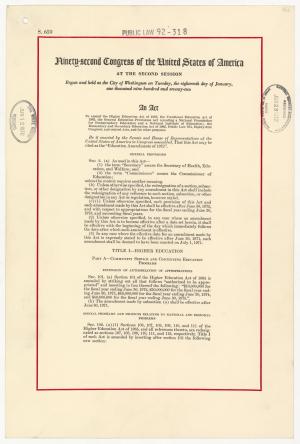Women, Education, Sports, and Title IX

How has Title IX impacted women in education and sports over the last 5 decades?
Supporting Questions:
- What is Title IX?
- Why was Title IX passed?
- How did Title IX impact access to athletics and education for women?
- What is the legacy of Title IX?
30 minutes recommended
- Students will be able to define Title IX.
- Students will be able to understand the impact of Title IX, specifically on women in education and sports.
- Students will be able to explore how Title IX legislation was part of a broader movement for gender equality.
- Students will be able to identify the success of Title IX but also reflect on the change that needs to occur for broader gender equality.
Students should have a general U.S. history background, including US history through the Civil Rights Movement. Students should be aware of earlier phases of feminism from Seneca Falls to the 19th Amendment.
- Youtube access for the various videos from the Makers program
- Transcripts of Title IX and the Senate Resolution on Title IX from 2016
Primary and Secondary Sources:
Warm Up: (8 minutes)
Watch the two videos. What challenges did women face in the sports world and how were they seen as inferior to their male counterparts?
Activity: (30 minutes total)
Part 1:“Turn and Talk” to your neighbors. What did you read, what do you think, what do you wonder?
Quote from archivist Margaret McAleer
Between 1951 and 1970 the education for women was shockingly discriminatory. There were quotas on admission to undergraduate and graduate programs, discrimination in access to scholarships and financial assistance, and discrimination in the hiring of women faculty. Only 18% of women had bachelors degrees and only 7.5% (294,015 girls) of high school girls participated in athletics in 1971. Today, close to 60% of undergraduates are women. During the 2012 Olympics, women representing the USA won 45 medals – 29 of them gold (Library of Congress).
Part 2: Read the below excerpt from Title IX and answer the following questions. This will follow with a class discussion:
- What is the purpose of Title IX?
- How do equal funding rules impact school sports and other educational endeavors?
- How do you think Title IX changed the role of young girls and women in sports?
- What do you think are the long-term effects of offering a more equal “playing field” for women in sports and other educational opportunities?
Excerpt from Title IX: (Passed in 1972)
No person in the United States shall, on the basis of sex, be excluded from participation in, be denied the benefits of, or be subjected to discrimination under any education program or activity receiving Federal financial assistance. (U.S. Department of Education)
Part 3: The 2016 Resolution on Title IX explains its impact.
- With a partner, read out loud the following document which cites the impact of Title IX forty-four years later. Here is the document. It is a resolution of the United States Senate.
- Write down two important successes of Title IX and two areas that still need improvement.
- As a class, share your findings.
Closing:
- Revisit the questions that were posed earlier. Are your answers the same or have you changed them in any way?
- What is the purpose of Title IX?
- How do equal funding rules impact school sports and other educational endeavors?
- How do you think Title IX changed the role of young girls and women in sports?
- What do you think are the long term effects of offering a more equal “playing field” for women in sports and other educational opportunities?
Students can apply what they have learned in this lesson to the world around them.
Questions:
- How does Title IX impact education today?
- Why is legislation often a necessary part of the reform process?
- Why is reform necessary for a democracy?
- What is necessary for change to happen in a society?
Modifications:
- This lesson can be modified by adding more time for reading activities.
- This lesson can be modified by the teacher reading the texts out loud for struggling readers.
D2.Civ.14.9-12. Analyze historical, contemporary, and emerging means of changing societies, promoting the common good, and protecting rights
D2.His.3.9-12. Use questions generated about individuals and groups to assess how the significance of their actions changes over time and is shaped by the historical context.
D2.His.5.9-12. Analyze how historical contexts shaped and continue to shape people’s perspectives.
D2.His.14.9-12. Analyze multiple and complex causes and effects of events in the past.
